Morphological Variability of the Thigh Muscle Traps in an Ultrasound That Awaits Clinicians
- PMID: 39860470
- PMCID: PMC11765969
- DOI: 10.3390/jcm14020464
Morphological Variability of the Thigh Muscle Traps in an Ultrasound That Awaits Clinicians
Abstract
Objectives: Muscles and their tendons present a considerable diversity of morphological variations. The aim of this study was to explore variants of muscles and tendons from compartments of the thigh and to raise awareness about potential problems during ultrasound examination. Materials and Methods: This comprehensive review of the literature was created on the basis of scientific articles sourced from PubMed. The search included all relevant papers related to the topic, ensuring that the most up-to-date studies were incorporated. In order to achieve these results, we created the exclusion criteria and extracted papers that did not meet the requirements of our review. Relevant papers were incorporated, and tracking of citations was fulfilled. The described method allowed for a broad yet detailed understanding, ensuring that the review of the literature covers all key aspects of the presented research. Results: Various aspects of thigh muscle anomalies were already undertaken; however, as this study has shown, current knowledge, while valuable, is insufficient to draw definitive conclusions regarding the prevalence and clinical implications of these muscle variations. A more robust body of ultrasound-based research is essential to accurately characterize these anomalies, establish their frequency, and assess their impact on clinical decision-making, including diagnostic accuracy, surgical planning, and therapeutic interventions. Conclusions: Numerous anatomical variations of the thigh muscles and tendons that were described in literature over the years might have clinical implications and could lead to mistakes during diagnosis by ultrasound imaging.
Keywords: adductor muscles; biceps femoris; imaging study; morphological variations; quadriceps femoris; sartorius; semimembranosus; semitendinosus; tensor fasciae suralis; tensor of the vastus intermedius; ultrasound.
Conflict of interest statement
The authors declare no conflict of interest.
Figures
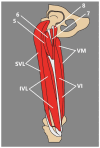

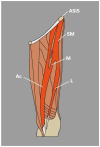
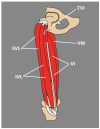


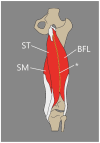
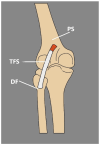
Similar articles
-
Tensor vastus intermedius: a review of its discovery, morphology and clinical importance.Folia Morphol (Warsz). 2021;80(4):792-798. doi: 10.5603/FM.a2020.0123. Epub 2020 Oct 21. Folia Morphol (Warsz). 2021. PMID: 33084009 Review.
-
A Literature Review of the Morphological Variability in the Intrinsic Muscles of the Foot: Traps Awaiting Clinicians during Ultrasound.J Clin Med. 2024 Jul 23;13(15):4286. doi: 10.3390/jcm13154286. J Clin Med. 2024. PMID: 39124554 Free PMC article. Review.
-
[Diffusion tensor imaging in quantitative evaluation on thigh muscle of male amateur marathon runners after running a half marathon].Zhonghua Yi Xue Za Zhi. 2022 Mar 8;102(9):642-647. doi: 10.3760/cma.j.cn112137-20210716-01591. Zhonghua Yi Xue Za Zhi. 2022. PMID: 35249307 Chinese.
-
Morphologic Characteristics and Strength of the Hamstring Muscles Remain Altered at 2 Years After Use of a Hamstring Tendon Graft in Anterior Cruciate Ligament Reconstruction.Am J Sports Med. 2016 Oct;44(10):2589-2598. doi: 10.1177/0363546516651441. Epub 2016 Jul 18. Am J Sports Med. 2016. PMID: 27432052
-
Anatomical variation of co-existing bilaminar tensor of the vastus intermedius muscle and new type of sixth head of the quadriceps femoris.Folia Morphol (Warsz). 2022;81(4):1082-1086. doi: 10.5603/FM.a2021.0095. Epub 2021 Sep 30. Folia Morphol (Warsz). 2022. PMID: 34590299
References
-
- Kędzia A., Wałek E., Podleśny K., Dudek K. Musculus Sartorius Metrology in the Fetal Period. Adv. Clin. Exp. Med. 2011;20:567–574.
-
- Plessis M.d., Loukas M. Bergman’s Comprehensive Encyclopedia of Human Anatomic Variation. John Wiley & Sons; Hoboken, NJ, USA: 2016. Thigh Muscles; pp. 410–420.
Publication types
LinkOut - more resources
Full Text Sources

